How Often Should You Run a Sprint Retrospective?

There are approximately 55 million meetings per day in the United States alone, yet, 71% of senior managers say that meetings are unproductive and inefficient. Because of that, choosing how often to have your retrospective meetings can be tricky, not to mention controversial. And getting it wrong can be costly.
You want to get the best return on investment possible from your retrospectives. And that means getting the timing just right.
By the end of this article you’ll be able to set a meeting interval that helps your team work better and smarter!
In this blog we’re going to cover:
When is a sprint retrospective held?
Sprint retrospectives are always held at the end of a sprint, which may last anywhere from one week to one month. Retrospectives are commonly held at the end of two-week sprints for teams practicing Scrum. The goal of a sprint retrospective is to look back over the sprint and consider ways to improve work quality and effectiveness.
The official Scrum Guide states that sprints are fixed-length events of one month per less. So the cadence of your sprint retrospectives will depend on and match the length of your sprints.
Why do teams run sprint retrospectives?
Retrospectives are a time for teams to reflect on what they have learned during a sprint, and are a key component of most agile project management methodologies, including Scrum.
Reflecting on every sprint gives teams an opportunity to identify problems and improvements early and often, and continuously improve how they work together.
The reason for running regular sprint retrospectives is to continuously improve working processes and quality. When retrospectives are held regularly improvements compound. The more retrospectives you run, the more you learn and the more opportunities you have to adapt and make small changes to improve the way you work.

Retrospectives help teams to:
- Resolve issues early and often
- Make continuous improvements by gathering and acting on feedback
- Create a culture of giving and receiving feedback
Retrospectives should take place at the end of each sprint, or at key points in your project timelines, like launching a new feature or reaching an important project milestone.
To decide how often to run a retrospective, you need to calculate the optimal sprint length for your team.
How long should my sprints be?
Sprints should be no-longer than one-month long. The core philosophy behind sprints, is that they should be short and quick so teams can release working software quickly and iterate. The shorter your sprints are, the more often you will hold retrospectives. And the more retrospectives you hold, the more your team will learn and create process improvements that increase efficiency and quality of work.
What happens when retrospectives are too frequent or infrequent
Let’s take a quick look at what could happen if your sprints are too long or too short.
When retrospectives are too frequent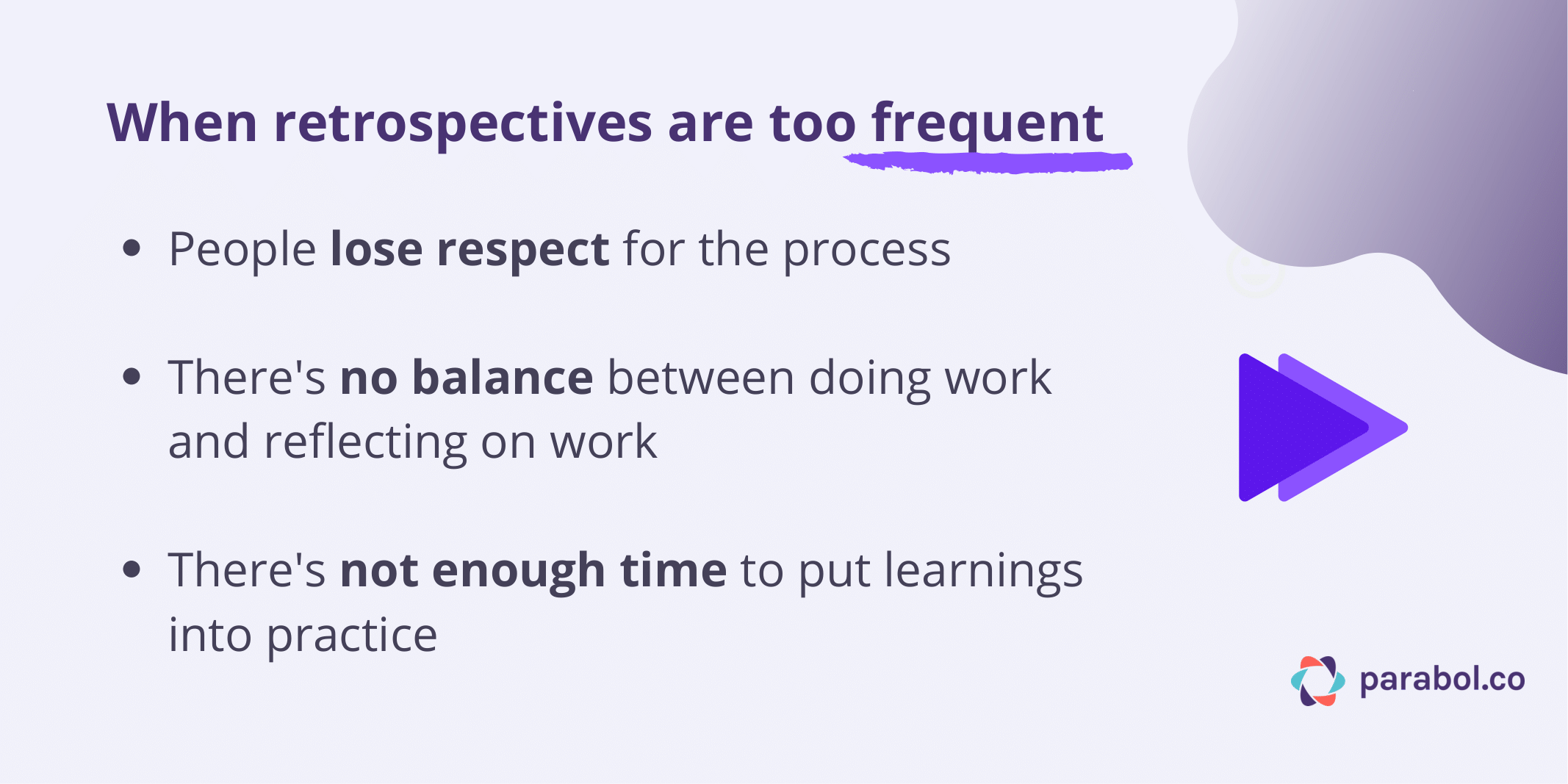
1. People lose respect for the process
Your team should all be focused, attentive, and serious during the retrospective process. The retrospective is a valuable time where everyone pauses their work to actively listen and contribute.
It’s the only hour you all come together and commit to the goal of continuous improvement, so it’s important to make it meaningful. That doesn’t mean you can’t have fun, but your team needs to respect the process and you need to ensure they find value in it.
If the retrospective doesn’t deliver valuable insights for the whole team, people can lose respect for the process. That makes it more difficult to get everyone contributing.
If you’re having retrospectives too often your team might also feel that they’re reflecting more than working, which can damage morale.
When people lose respect for the retrospective process, it’s difficult to build it up again. So make sure to space your retrospectives wisely.
2. There’s no balance between doing work and reflecting on work
Your goal as a project manager or Scrum master is to get the most out of your team. You want to ensure your team are using their time in the most valuable way possible. Too many meetings can mean wasted time, especially since people are naturally skeptical about the value of meetings.
Time spent in overly regular meetings is time taken away from meaningful development or project work.
You need time to do meaningful work during the sprint if you’re going to generate meaningful insights.
Great organizations use meetings as a strategic tool and think about how they can get the most out of them. If your meeting is not helping your team to perform to the best of their ability, then make the meeting less frequent or change its format.
3. There’s not enough time to put learnings into practice
Retrospectives help your team generate insights for continuous improvement. At the end of every retrospective, you will come away with action items for different team members to implement.
These action items are a vital part of the retrospective process, because they allow your team to course-correct mid-project if something isn’t going well.
But if you are having meetings too frequently, your team members won’t have time to effectively implement changes. Before you know it, you’re all back at your next retrospective discussing the same challenges, because there wasn’t enough time to put learnings into practice.
That leads teams to feel that they don’t act on what they learn in retrospectives, which erodes respect for the retro. It’s a vicious cycle.
Meetings need to be spaced out enough that action items can be genuinely implemented and their impacts assessed.
Otherwise your team will drown in action items that can’t be implemented in the allotted time while technical debt and project backlogs pile up. There’s nothing worse than having action items linger from sprint to sprint.
When retrospectives are too infrequent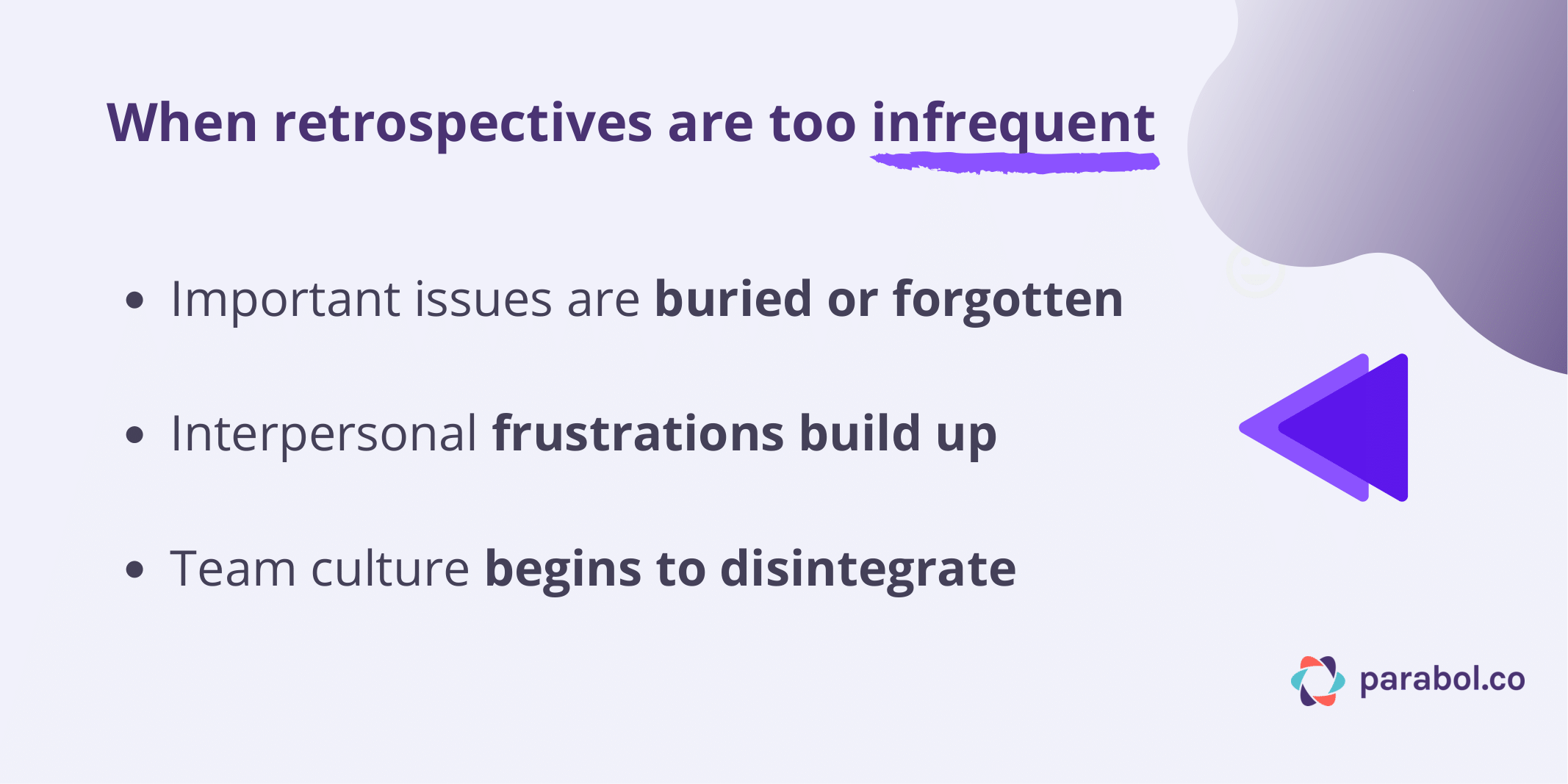
1. Important issues are buried or forgotten
Retrospectives are a chance for your team to voice any concerns or observations they have about inefficiencies. Having regular retrospectives ensures your team are raising important findings during the course of a project.
When retrospectives are too infrequent there’s no mechanism to regularly identify improvements. Instead, your team will struggle on, weighed down by undiagnosed inefficiencies that could be easily resolved.
If it’s clear that issues are persisting longer than they should be, you might need to make your retrospectives more frequent.
Another thing to note is that if you’re trying to reflect on a whole quarter, and only have one meeting to do it, you forget important things. This means feedback becomes broad and non-specific because you’re trying to find patterns across a long space of time.
So instead of saying “one press release got stuck in review and that caused a delay we could have avoided” you end up saying “we reviewed press releases pretty quickly in general,” which is less useful.
2. Interpersonal frustrations build up
Your retrospective is not only a time to evaluate work, but also to connect with each other. If something isn’t working properly, your team members have an opportunity to explain why and work together to make a change — turning tension into collaboration. It’s also a chance to express to other team-mates if there’s a better way to work together.
If your retrospectives are too infrequent, frustrations can build up within your team that negatively impact productivity and team morale.
Retrospectives work because they are built on the assumption that everyone can be honest with each other. Being regular with your retrospectives prevents team frustrations building up and becoming toxic.
3. Your team culture begins to disintegrate
Icebreakers are a key component of our retrospectives at Parabol. For us, retrospectives aren’t just a time to discover lessons-learned, but also to connect with each other on a personal level.
This step is particularly important for fully distributed or remote teams that need to work even harder to build social cohesion. Social check-ins also prime your team to share the kinds of issues and frustrations that serve as the foundation for really fruitful discussions and important improvements.
Taking the time to build personal context about your team members helps you develop stronger working relationships and culture. The format of a retrospective is geared towards building strong relationships.
Retrospectives are all about opening up and sharing what isn’t working for you. But they are also about receiving validation from the team that what you say matters and that everyone will pitch in to solve the problem.
It’s a fact that social bonds make teams resilient and motivated.
If you’re not meeting regularly enough those bonds can begin to disintegrate, which might cause conflict in your team.
So how often should you run a retrospective?

There is no one-size-fits-all approach to how often you should run a retrospective, but there’s a lot of guidance out there about how long a sprint should be, and we can use those as a starting place.
Developing your sprint length will help you decide how often to hold retrospectives.
According to Scrum methodology, a sprint should last for a period of up to 4 weeks, and the corresponding retrospective should be no more than 4 hours.
But in reality you might find that 4 weeks is a bit too long.
Most agile coaches suggest that it’s better to start off with shorter sprints for new teams. Shorter sprints ensure learnings don’t get lost, frustrations don’t build up, and you have enough contact to build a strong team culture from the get go.
Data on sprint retrospective length and cadence
At the time of writing, over 3,500 retrospectives are held every week on Parabol – our free agile retrospectives tool. So we wondered if the data of our users had an interesting story to tell us about how often teams run retrospectives.
We found that the majority of users run a retro at least every 2 weeks.
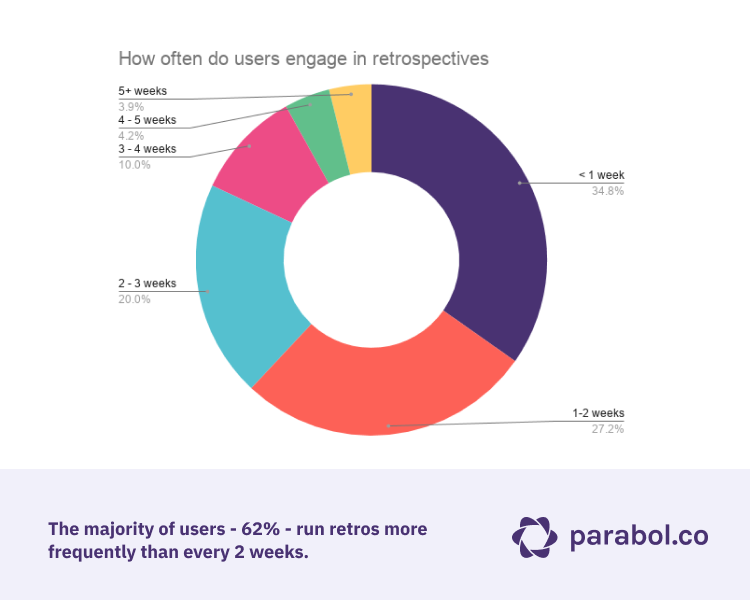
When looking at how frequently users come back to run another retro, users commonly come back every 7 or 14 days.
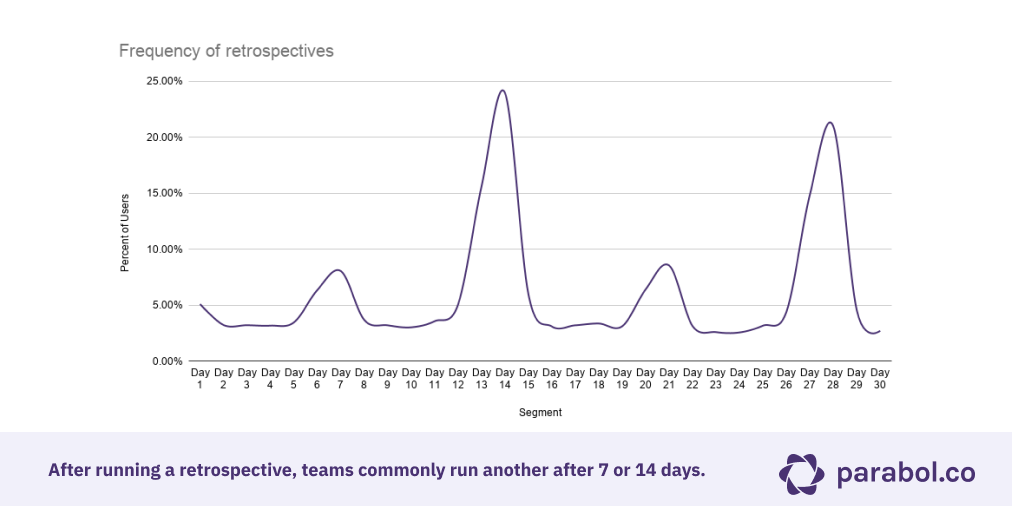
Most users spend 30 to 90 minutes in a retrospective, but teams that gather feedback asynchronously typically take 2 to 5 days to run their retrospectives.
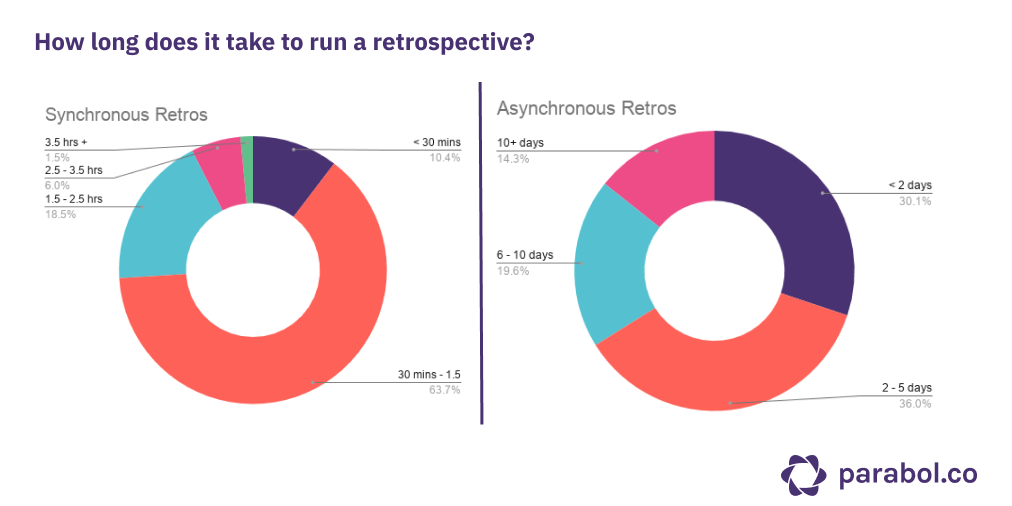
Finding the right sprint length is all about finding a balance between giving people the space for ‘deep work’ and the opportunity to identify problems before they become ingrained.
According to Aaron Dignan, founder of The Ready and author of the book Brave New Work:
“Retrospectives should match the rhythm of the work they’re evaluating. So, if we’re talking about a company or institution, it might be quarterly, or even yearly. But for a project team on the ground, it might be monthly or even weekly. The questions to ask yourself are, “How fast are we learning? How fast do we want to learn?”
As a rule of thumb, he says that teams should:
“Start with what intuitively feels like too short a sprint, and then expand the length based on what you experience. It’s easier to let the rope out than it is to take it in.”
Conclusion
There is no cookie cutter approach to how often you should schedule retrospectives. The most important thing is to start somewhere and give time for your meeting cadence to emerge organically.
If you’re starting a new team, you should:
1. Begin: If there’s no existing rhythms to plug into, start with regular retrospectives every 7-10 days
2. Reflect: Ask your team to reflect on whether the retrospective interval is optimal
3. Adapt: Extend or contract your retrospective interval according to your needs (2-3 weeks for most teams)
Remember, retrospectives can take place at any interval you want them to. If your key project milestones are at the end of every month, then hold a project retrospective every month. If you’re working in sprints, your sprint retrospectives should be in step with your sprint cadence. It all depends on the context of your work and your team.
When you start running retrospectives, there are a few tips you can take away:
- Getting your sprint length right helps you optimise team performance
- Having too many retrospectives can damage morale and respect for the process
- Retrospectives should take place at regular intervals to encourage continuous improvement
- Retrospectives should never be skipped
- Finding what works best for your team is more important than copying what others do
You should now be ready to start setting your sprint length, organising your retrospectives, and pulling in insights that boost your team’s performance!








